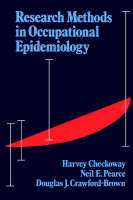
Research Methods in Occupational Epidemiology
Seiten
1989
Oxford University Press Inc (Verlag)
978-0-19-505224-4 (ISBN)
Oxford University Press Inc (Verlag)
978-0-19-505224-4 (ISBN)
- Titel erscheint in neuer Auflage
- Artikel merken
Zu diesem Artikel existiert eine Nachauflage
Occupational epidemiology has emerged as a distinct subdivision of epidemiology. This book draws together the wide range of principles and methods used in epidemiological studies of working populations.
Occupational epidemiology has emerged as a distinct subdiscipline of epidemiology and occupational medicine, addressing fundamental public health and scientific questions relating to the specification of exposure-response relationships, assessment of the adequacy of occupational exposure guidelines, and extrapolation of hazardous effects to other settings. This book reviews the wide range of principles and methods used in epidemiological studies of working populations. It describes the historical development of occupational epidemiology, the approaches to characterizing workplace exposures, and the methods for designing and implementing epidemiological studies. The relative strengths and limitations of different study designs are emphasized. Also included are more advanced discussions of statistical analysis, the estimation of doses to biological targets, and applications of the data derived from occupational epidemiology studies to disease modelling and risk assessment. The volume will serve both as a textbook in epidemiology and occupational medicine courses and as a practical handbook for the design, implementation, and interpretation of research in this field.
Occupational epidemiology has emerged as a distinct subdiscipline of epidemiology and occupational medicine, addressing fundamental public health and scientific questions relating to the specification of exposure-response relationships, assessment of the adequacy of occupational exposure guidelines, and extrapolation of hazardous effects to other settings. This book reviews the wide range of principles and methods used in epidemiological studies of working populations. It describes the historical development of occupational epidemiology, the approaches to characterizing workplace exposures, and the methods for designing and implementing epidemiological studies. The relative strengths and limitations of different study designs are emphasized. Also included are more advanced discussions of statistical analysis, the estimation of doses to biological targets, and applications of the data derived from occupational epidemiology studies to disease modelling and risk assessment. The volume will serve both as a textbook in epidemiology and occupational medicine courses and as a practical handbook for the design, implementation, and interpretation of research in this field.
Introduction; Characterizing the workplace environment; Overview of study designs; Issues of study design and analysis; Cohort studies; Case-control studies; Cross-sectional studies; Advanced statistical analysis; Dose and exposure modeling; Special applications of occupational epidemiology data
| Erscheint lt. Verlag | 24.8.1989 |
|---|---|
| Reihe/Serie | Monographs in Epidemiology & Biostatistics ; No.13 |
| Zusatzinfo | figures and tables throughout |
| Verlagsort | New York |
| Sprache | englisch |
| Maße | 156 x 234 mm |
| Gewicht | 730 g |
| Themenwelt | Studium ► Querschnittsbereiche ► Epidemiologie / Med. Biometrie |
| ISBN-10 | 0-19-505224-2 / 0195052242 |
| ISBN-13 | 978-0-19-505224-4 / 9780195052244 |
| Zustand | Neuware |
| Haben Sie eine Frage zum Produkt? |
Mehr entdecken
aus dem Bereich
aus dem Bereich
ein überfälliges Gespräch zu einer Pandemie, die nicht die letzte …
Buch | Hardcover (2024)
Ullstein Buchverlage
24,99 €



